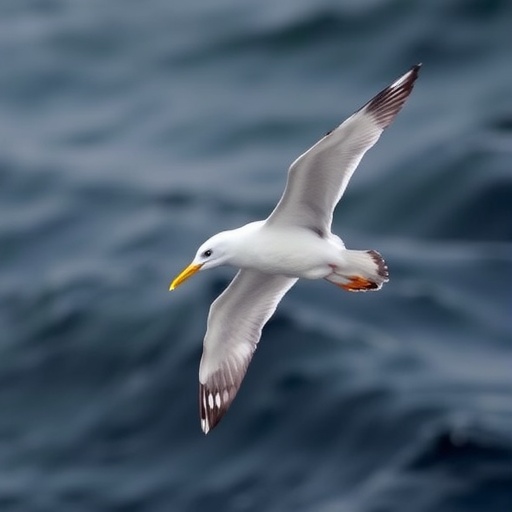In a surprising discovery that sheds new light on the subtle behaviors of marine birds, researchers from the University of Tokyo have unveiled the unique excretion patterns of streaked shearwaters (Calonectris leucomelas) during flight. Published recently in the acclaimed journal Current Biology, their study reveals that these seabirds defecate exclusively while airborne, not when resting on the ocean surface, and do so with remarkable periodicity approximately every 4 to 10 minutes. This rhythmic and airborne bathroom habit challenges previous assumptions about seabird physiology and ecology, offering new perspectives on their role within marine ecosystems.
The study’s lead author, Leo Uesaka, initially embarked on an investigation into the mechanics of how these seabirds manage takeoff from the ocean’s surface. Through the employment of innovative, eraser-sized backward-facing cameras secured to the birds’ bellies, the research team unexpectedly observed an unanticipated high frequency of defecation events during flight. What was first perceived as a curious anecdote soon revealed itself as a significant behavioral pattern that might be crucial for the birds’ hygiene, predator avoidance, and ecological interactions.
Seabird excreta is known to be rich in nitrogen and phosphorus, essential nutrients that substantially influence both terrestrial and marine ecosystems. While the fertilizing effect of seabird droppings on land has been well-documented—boosting soil fertility and promoting vegetation growth—the dynamics of these nutrients in open ocean environments remain less understood. With an estimated global population exceeding 400 million shearwaters and related species, the collective contribution of their fecal matter to the ocean’s nutrient cycles could be profoundly significant, possibly enhancing planktonic communities and broader marine food webs.
The technical approach of attaching compact cameras to the birds enabled the precise documentation of almost 200 defecation events. Analysis indicated a consistent pattern: shearwaters nearly always defecate in flight, with defecation closely linked to takeoff events. Intriguingly, some birds appeared to perform deliberate short flights specifically to relieve themselves, only to return to the water promptly afterward. Such behavior implies a purposeful avoidance of defecating while resting on the ocean surface, suggesting adaptive advantages potentially tied to feather maintenance and predator evasion.
Detailed observations revealed that the aerodynamic design of streaked shearwaters—specifically their elongated and slender wings optimized for gliding rather than flapping—places a high energetic cost on takeoff. Since vigorous wing flapping is required to lift from the water, the birds seem to weigh the energy expense against the imperative to maintain feather cleanliness and avoid fouling with feces. This trade-off likely motivates their airborne defecation strategy, as soiling feathers on the water would compromise flight efficiency and increase vulnerability.
Furthermore, defecation in flight might serve as a mechanism to reduce predation risk. By avoiding excreta on the floating surface, shearwaters possibly minimize olfactory and visual cues that predators could exploit. Additionally, relieving themselves midair may be mechanically easier than doing so while floating, potentially due to hydrodynamic constraints or balance issues on the water’s surface. Despite the energy cost of extra takeoffs, these benefits seem to have driven the evolution of this periodic excretion rhythm.
Quantitative measurements estimate that these seabirds excrete approximately 30 grams of fecal matter per hour, accounting for roughly 5% of their body mass. This substantial nutrient flux entering the marine environment every hour underscores the importance of considering seabird defecation within broader biogeochemical cycles. The repetitive pattern and volume of fecal output hint at underlying physiological or energetic rhythms that remain unexplained but are evidently critical to the species’ lifestyle.
The ongoing mystery surrounding why shearwaters maintain such a strict excretion timing invites further investigation. The researchers plan to enhance their methodology by integrating longer-lasting cameras, temperature sensors, and GPS devices. This future work aims to spatially map where seabirds deposit their droppings in the open ocean, identifying hotspots of marine fertilization and deepening understanding of seabird contributions to nutrient dynamics in pelagic zones.
Beyond mere curiosity about seabird behavior, this research highlights a broader ecological narrative. The invisible flow of nutrients mediated by seabird poop is a foundational process underpinning the productivity of marine food chains. As these birds traverse vast ocean stretches, their feces fertilize water columns, supporting primary producers like phytoplankton, which form the base of oceanic ecosystems. Recognizing the significance of this phenomenon may open new pathways for marine conservation and ecosystem management, especially in the context of changing oceanic conditions.
Leo Uesaka eloquently encapsulates the broader perspective gained through this work, stating, “Feces are important. But people don’t really think about it.” This candid remark belies the complex interdependencies that fecal matter engenders across biological systems. It suggests that even the most seemingly mundane biological processes warrant rigorous scientific scrutiny, as they can reveal keystone interactions and insights into species survival strategies.
The implications for marine ecology are profound. Understanding seabird excretion patterns not only enriches our knowledge of avian physiology and behavior but also frames these birds as vibrant, active agents in ocean nutrient cycles rather than passive inhabitants. This paradigm shift may encourage renewed attention to the vast, interconnected web of life supported by nutrient fluxes generated through such animal behaviors.
Supporting the research were grants from Japan’s JSPS, the Japan Science and Technology Agency SPRING program, and cooperative efforts from the Atmosphere and Ocean Research Institute of the University of Tokyo. Their participation underscores the interdisciplinary nature of such ecological inquiries, bringing together technological innovation, animal behavior studies, and marine biogeochemistry in a compelling narrative of discovery.
The paper, titled “Periodic excretion patterns of seabirds in flight,” offers a fresh scientific pursuit with significant potential ramifications. As further studies unravel the subtleties of these patterns and their environmental repercussions, this research establishes a crucial foundation for appreciating the intricate and often overlooked roles of seabirds within the ocean’s very fabric.
Subject of Research: Animals
Article Title: Periodic excretion patterns of seabirds in flight
News Publication Date: 18-Aug-2025
Web References:
http://www.cell.com/current-biology
http://dx.doi.org/10.1016/j.cub.2025.06.058
References:
Uesaka, L. & Sato, “Periodic excretion patterns of seabirds in flight,” Current Biology, August 18, 2025
Image Credits: Leo Uesaka
Keywords:
Seabirds, Birds, Marine ecology




